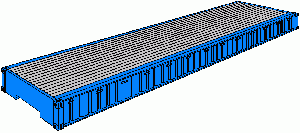 |
40' platform: 8' wide and 2' high with gooseneck tunnel at both ends |
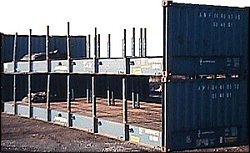 |
Group code PF covers type codes P1 and P2. |
| Half-height flats falling under P1, with lateral insertable stanchions |
P1 platforms have two complete, fixed end walls, irrespective of how high they are.
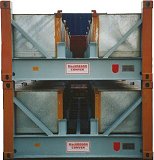 |
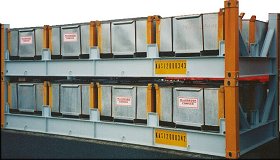 |
| Platform containers falling under P2 with corner posts and special load retainers | |
P2 platforms have fixed posts, either free-standing or with removable top members. The containers illustrated here are specially constructed to accommodate stacking boxes. The boxes are carrying cargo securing materials for securing the containers on board. They are naturally also ideal for transporting other heavy small parts.
Group code PC covers type codes P3 and P4. P3 platforms have folding complete end walls.
 |
40' platform with completely folding end walls - collapsed |
| 40' platform with completely folding end walls | 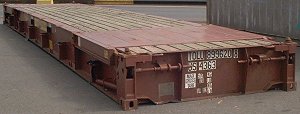 |
P4 platforms have folding posts, either free-standing or with removable top members.
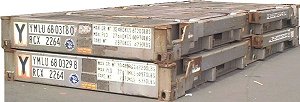 |
20' platform with folding free-standing corner posts - folded down in pairs |
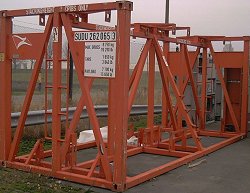 |
Group code PS covers type codes P5 to P9. P5 platforms are open at the top and ends (skeletal). |
| Frames for suspension of clip-on units |
| In the January 1996 edition, type codes P6 to P9 had not been assigned, but were kept as spares. Here is an example of how one of these codes has been assigned by Hapag-Lloyd: | 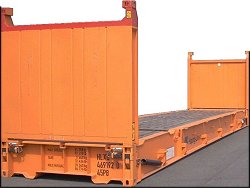 |
| 40' x 8' x 9'6" P8 platform |
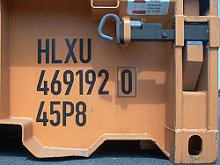 |
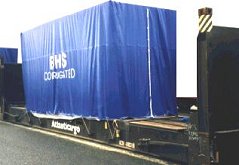 |
| Detail of P8 platform | 40' collapsible flatrack with overheight, collapsible end walls |
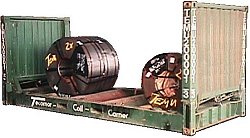 |
Coil container with folding end walls |
Coil containers are built like flats or flatracks, i.e. they consist of a container floor and flat or frame-like end walls. The container floor has cargo troughs for accommodating coils/rolls of steel sheet. Cargo securing costs are lower, since less complex lashing and blocking is required than on/in normal containers. However, when overall transport costs, including the return transport of empty coil containers, are taken into account, normal carriage without a special container may be more economical. Coil containers could be included amongst named cargo containers, but they are not covered by the standard.
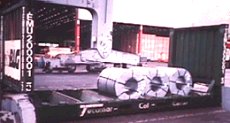 |
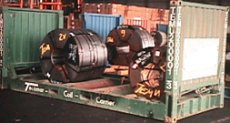 |
| 20' flatracks, with fold-down end walls and coil wells (coil containers) | |
Tank containers are provided for carrying liquids and gases. The characteristics of the substances to be carried determine the material of which the tank is made, while the pressure under which the cargo has to be transported influences its construction. Tank containers almost always have as their basis a steel frame, into which tanks of various shapes may be inserted. Various fittings and accessories are incorporated, depending on type and method of filling and emptying. Temperature-controlled tank containers require special heating or cooling devices. They may be filled via domes or tubes and emptied downwards via floor drains or upwards via riser pipes and pressure generators or in any other suitable manner. The products to be carried may be any types of liquid, liquefied or gaseous substance, ranging from harmless to very dangerous.
Tank containers for non-dangerous liquids come under group code TN. Type codes T0, T1 and T2 distinguish between minimum pressures of 45 kPa, 150 kPa and 265 kPa.
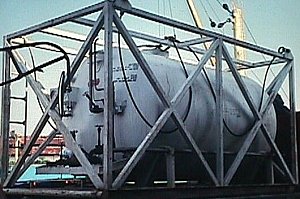 |
Tank container for non-dangerous liquids |
Tank containers intended for liquid foodstuffs must be clearly marked as being intended for this purpose:
Half-height tank containers or half-height liquid containers serve to carry high-density liquids which cannot be carried in normal tank containers because they cannot be filled to a high enough level and are therefore subject to surging.
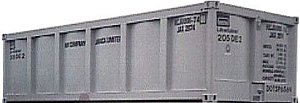 |
Half-height liquid container |
Tank containers for dangerous liquids come under group code TD. Type codes T3, T4, T5 and T6 distinguish between minimum pressures of 150 kPa, 265 kPa, 400 kPa and 600 kPa.
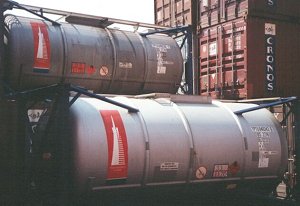 |
Tank containers for carrying dangerous liquids |
Such containers are subject, among other things, to the regulations governing the carriage of hazardous materials and may also have to be tested for compliance with the regulations of the Department of Transportation (DOT) or the German Federal Institute for Materials Research and Testing (BAM).
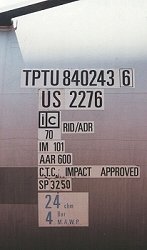 |
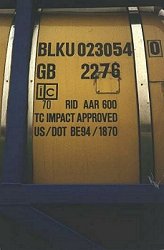 |
20' x 8'6" tank container for hazardous materials with a test pressure of 600 kPa |
Tank containers for gases are assigned to group code TG and type codes T7, T8 and T9. T7 and T8 cover minimum pressures of 910 kPa and 2,200 kPa, while T9 does not as yet have a pressure assigned to it.
Tank containers must be at least 80% full for safety reasons, so as to prevent dangerous surging of the liquids in transit. As a rule of thumb, they should not be filled more than 95% full, so as to allow for thermal expansion of the contents.
The CTU packing guidelines state under the heading "Scope":
-
... They do not cover the filling or emptying of tank containers, portable tanks, or road tank vehicles, or the transport of any bulky cargo in bulk packagings.
Tank containers may be replaced by introducing "flexible tubes" into standard containers, so turning them into temporary tank containers. However, a major problem associated with this is surging of the liquids, which may result in damage to the container walls.
Frequently used terms and comments:
Closed containers include all non-ventilatable general purpose, dry bulk and tank containers. These containers allow no or only very slight air exchange. They are consequently gas-tight or at any rate virtually gas-tight. They are not suited to transporting goods which require an exchange of gases.
The phrase design for ease of opening is found in container literature in relation to the desire for rapid packing and unpacking. It is often used in relation to dry bulk containers with special openings.
Half-height containers are lower than standard containers. The size codes distinguish between those 1,295 mm (4'3") high and those of a height less than or equal to 1,219 mm (4'). The containers are specially designed for goods with low stowage factors and for high-density cargoes, such as heavy barrels, metal sheet etc.
The following needs to be said with regard to special containers: from a technical point of view, these meet the needs of many forwarders and are desirable with regard to cargo securing. Their special fittings simplify packing and cargo securing, reducing securing costs and shipping risks. However, since they are adapted to one product or group of products to be transported, it is more difficult to use them on all routes, resulting in higher freight rates than for standard containers due to more frequent carriage of empty containers. From the point of view of cargo safety, however, special containers developed for a particular product are preferable to conventional containers.
All wooden parts of containers traveling to Australia and New Zealand, including packaging and securing lumber, must be treated, and proof must be provided in the form of appropriate wood treatment certificates. The wooden parts of most containers are impregnated against insect infestation. Australia's and New Zealand's quarantine regulations require proof in the form of a plate:
| This provides documentary evidence that the wooden parts have been treated against the Sirex wasp. |